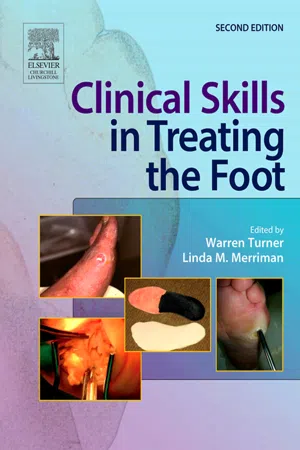
- 496 pages
- English
- ePUB (mobile friendly)
- Available on iOS & Android
Clinical Skills in Treating the Foot
About this book
The eagerly awaited new edition of Clinical Skills in Treating the Foot has been revised and updated with the needs of a broad range of health professionals in mind. For anyone treating patients with foot disorders, Clinical Skills in Treating the Foot will provide invaluable support through three key areas: Section 1 is concerned with the general principles of managing foot disorders and the context in which treatment of the foot takes place. Included are chapters on treatment planning, evidence based practice, governance and audit, clinical protocols, clinical emergencies and health promotion. Section 2 examines the application of clinical therapeutics to foot disease and includes chapters on operative techniques, surgery and the foot, pharmacology, physical therapy, mechanical therapeutics, chairside devices, prescription devices and footwear therapy. Section 3 considers the particular needs of special groups and includes chapters on the adult foot, the child's foot, sports injuries and management of tissue viability. With its clarity of text and liberal use of case studies and illustrations, the latest edition of Clinical Skills will be required reading for practising and student podiatrists. It will also be a valuable reference and guide for all others involved in the provision of treatment of the foot. This book has been written as a companion volume to the editors' Assessment of the Lower Limb, also published by Elsevier Churchill Livingstone.- Written by an experienced team of clinicians who also understand the needs of students as well as practitioners- Logical and clear structure makes it easy to use for both clinicians and students- Each chapter is self-contained and can be used for independent reading topics- Case histories and clinical comment sections illustrate important clinical points- Key points and summaries provides assistance for learning and review- Features approximately 400 illustrations- Half of the contributors are new - more experienced clinicians than those used for the previous edition- New chapter by new author on Clinical Governance (replacing old chapter of Audit and Outcome Measurement)- Major revision by new authors of chapter on Treatment Planning to reflect new developments and changes in pracice- Completely rewritten chapter by new authors on Clinical protocols- Major revision by new author of the chapter on Foot health education and promotion- Major rewrite with new author of the chapter on Pharmacology which will have expanded sections on topical and injected steroids and prescription medicines.- Major revision by new authors of the chapter on Physical therapy- New section on chairside devices in the chapter on Mechanical therapeutics in the clinic (new authors involved)- Chapter on Prescription orthoses now replaced with new chapter by new authors on Prescription devices..- Major rewrite by new author of the chapter on sports injuries- New chapter on Managing tissue viability repaces the old chapter on the Management of foot ulcers and now incorporates the material previously covered in old appendices 1 and 2 on Management of exudation in ulcers and Footcare advice for people with diabetes.
Frequently asked questions
- Essential is ideal for learners and professionals who enjoy exploring a wide range of subjects. Access the Essential Library with 800,000+ trusted titles and best-sellers across business, personal growth, and the humanities. Includes unlimited reading time and Standard Read Aloud voice.
- Complete: Perfect for advanced learners and researchers needing full, unrestricted access. Unlock 1.4M+ books across hundreds of subjects, including academic and specialized titles. The Complete Plan also includes advanced features like Premium Read Aloud and Research Assistant.
Please note we cannot support devices running on iOS 13 and Android 7 or earlier. Learn more about using the app.
Information
Treatment planning
INTRODUCTION
WHO NEEDS TREATMENT FOR DISORDERS OF THE FOOT?
| Type of need | Description |
| Normative | Need defined by an expert |
| Felt | A want expressed by the patient or a third party |
| Expressed | A felt need which is turned into action (demand) |
| Comparative | Arrived at by studying the characteristics of people in receipt of a service and identifying those with similar characteristics, but not in receipt, as being in need |
Table of contents
- Cover image
- Title page
- Table of Contents
- Copyright
- Contributors
- Preface
- Acknowledgements
- Section 1: Essential principles of management
- Section 2: Methods of managing foot conditions
- Section 3: Managing specific client groups
- Appendices
- Index